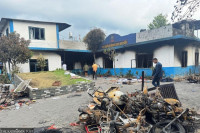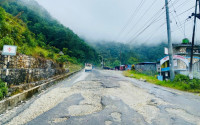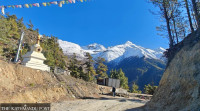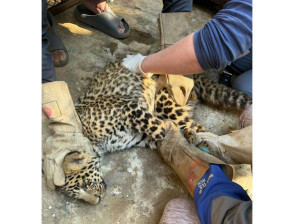Gandaki Province
Camera traps installed in Tanahun community forests to study leopard population and their prey
Seventy-two camera traps have been installed in various community forests of Bhanu Municipality as officials suspect low prey numbers are driving leopards into human settlements.
Samjhana Rasaili
On November 7, a team led by Kedar Baral, chief at the Division Forest Office in Kaski, installed camera traps in various community forests in Bhanu Municipality, Tanahun, to monitor the movement of leopards.
Many locals have reported sightings of leopards in the area with some of the big cats even venturing into the settlements.
According to the data of the Division Forest Office in Tanahun, there are 96 community forests (which cover 5,777 hectares of land) in Bhanu Municipality. The office, however, does not have data on the exact number of leopards that live in these forests.
The Division Forest Office has installed 72 camera traps in community forests of Ward No. 1, 2, 3, 4 and 5 of Bhanu Municipality to keep track of the local leopard population, their movement and their habits.
“We have installed 65 cameras so far. We have divided the forest area into 36 grids. There is a pair of cameras installed in each grid,” said Baral.
Officials suspect that the reason behind the leopards entering the human settlements is due to the lack of prey in forests.
“The cameras have been installed to record the number of leopards as well as the number of their prey,” said Baral. “We will soon be able to prepare a proper database. This will help us mitigate human-wildlife conflict in the area by a great degree.”
The cameras will be placed in each grid for around 15 days and the collected visuals will be studied later.
“If the visuals show more leopards in certain areas and fewer in others, we will shift the cats from crowded areas to somewhere less crowded. This will create a balance between the cats and their prey numbers,” said Baral. “This whole exercise and study will help us in leopard conservation.”
The Division Forest Office in Tanahun and the community forests have worked together to set up the camera traps.
Out of 22 community forests adjacent to the areas with frequent leopard sightings, a camera trap has captured an image of a leopard in Majuwa Okle Community Forest in Ward No. 2 of Bhanu Municipality recently.
“Camera traps were installed in Majuwa area initially. We have started to collect the images of leopards and other wild animals including rabbits, bears and wild cats,” said Baral.
Prem Thapa, chairman of Bhimthumki Community Forest Consumers Committee in Ward No. 1 of Bhanu Municipality, said, “We hope that the number of the human-wildlife conflict will decrease in the near future. Camera traps will help us know the exact number of leopards and their prey. Since we don’t know the exact leopard population, we are having problems managing the predator-prey ratio.”
In the last two years, six children were mauled to death by leopards in Bhanu Municipality alone. The first leopard attack in the municipality was reported on February 13, 2018. According to the data of the Division Forest Office in Tanahun, 10 children were killed in separate leopard attacks in Bhanu, Anbu Khaireni, Bandipur and Shuklagandaki in the past two years. Likewise, 167 cattle were attacked by leopards within five years, the record showed. Also, nine leopards were captured alive and 11 leopards were found dead within five years.
Prem Thapa, a native of Bhanu Municipality Ward No. 1, said, “We are relieved to some extent with the authorities finally making an effort to mitigate human-wildlife conflict. Leopard attacks have become a major problem in our area. Leopards find easy prey in children. That’s why we don’t let our children out of our sights. We have to walk in groups and never go out alone during evenings and early mornings.”




 16.12°C Kathmandu
16.12°C Kathmandu











